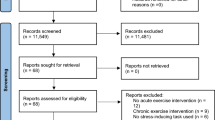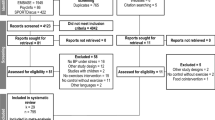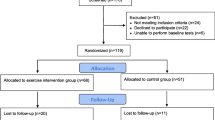Abstract
Background
Psychosocial stress is associated with multiple health complaints. Research to date suggests that regular physical activity (PA) and higher cardiorespiratory fitness may reduce stress reactivity and therefore contribute to a reduction of stress-related risk factors. While previous reviews have not differentiated between stressors, we focus on psychosocial stress elicited with the Trier Social Stress Test (TSST).
Objective
Our objective was to examine the effect of regular PA and cardiorespiratory fitness on stress reactivity, with a particular focus on the TSST. The TSST is the laboratory task most widely used to induce socio-evaluative stress and elicits stronger stress reactions than most other cognitive stressor tasks.
Methods
A systematic search within various databases was performed in January 2018. The following outcomes were considered: cortisol, heart rate, psychological stress reactivity, and potential moderators (age, sex, exercise intensity, assessment mode, and psychological constructs).
Results
In total, 14 eligible studies were identified. Cortisol and heart rate reactivity were attenuated by higher PA or better fitness in seven of twelve studies and four of nine studies, respectively. Two of four studies reported smaller increases in anxiety and smaller decreases in calmness in physically active/fitter participants. Three of four studies found that higher PA/fitness was associated with more favorable mood in response to the TSST.
Conclusion
About half of the studies suggested that higher PA/fitness levels were associated with an attenuated response to psychosocial stress. Currently, most evidence is based on cross-sectional analyses. Therefore, a great need for further studies with longitudinal or experimental designs exists.

Similar content being viewed by others
References
Cohen S, Janicki-Deverts D, Miller GE. Psychological stress and disease. JAMA. 2007;298:1685–7. https://doi.org/10.1001/jama.298.14.1685.
Holmes ME, Ekkekakis P, Eisenmann JC. The physical activity, stress and metabolic syndrome triangle: a guide to unfamiliar territory for the obesity researcher. Obes Rev. 2010;11:492–507. https://doi.org/10.1111/j.1467-789X.2009.00680.x.
Thoits PA. Stress and health: major findings and policy implications. J Health Soc Behav. 2010;51(Suppl):S41–53. https://doi.org/10.1177/0022146510383499.
Middlebrooks JS, Audage NC. The effects of childhood stress on health across the lifespan. Atlanta: Centers for Disease Control and Prevention, National Center for Injury Prevention and Control; 2008.
McEwen BS. Central effects of stress hormones in health and disease: understanding the protective and damaging effects of stress and stress mediators. Eur J Pharmacol. 2008;583:174–85. https://doi.org/10.1016/j.ejphar.2007.11.071.
Kivimäki M, Virtanen M, Elovainio M, Kouvonen A, Väänänen A, Vahtera J. Work stress in the etiology of coronary heart disease: a meta-analysis. Scand J Work Environ Health. 2006;32:431–42.
Booth J, Connelly L, Lawrence M, Chalmers C, Joice S, Becker C, Dougall N. Evidence of perceived psychosocial stress as a risk factor for stroke in adults: a meta-analysis. BMC Neurol. 2015;15:233. https://doi.org/10.1186/s12883-015-0456-4.
Bergmann N, Gyntelberg F, Faber J. The appraisal of chronic stress and the development of the metabolic syndrome: a systematic review of prospective cohort studies. Endocr Connect. 2014;3:R55–80. https://doi.org/10.1530/EC-14-0031.
Segerstrom SC, Miller GE. Psychological stress and the human immune system: a meta-analytic study of 30 years of inquiry. Psychol Bull. 2004;130:601–30. https://doi.org/10.1037/0033-2909.130.4.601.
Redmond N, Richman J, Gamboa CM, Albert MA, Sims M, Durant RW, et al. Perceived stress is associated with incident coronary heart disease and all-cause mortality in low- but not high-income participants in the Reasons for Geographic And Racial Differences in Stroke study. J Am Heart Assoc. 2013;2:e000447. https://doi.org/10.1161/JAHA.113.000447.
Ludyga S. Sportaktivität, Stress und das Gehirn. In: Fuchs R, Gerber M, editors. Stressregulation und sport. Heidelberg: Springer; 2017. p. 275–91.
Pines AM, Keinan G. Stress and burnout: the significant difference. Pers Individ Differ. 2005;39:625–35. https://doi.org/10.1016/j.paid.2005.02.009.
Bauman AE. Updating the evidence that physical activity is good for health: an epidemiological review 2000–2003. Zs Sportpsychol. 2004;7:6–19. https://doi.org/10.1016/S1440-2440(04)80273-1.
Biddle SJH, Asare M. Physical activity and mental health in children and adolescents: a review of reviews. Br J Sports Med. 2011;45:886–95. https://doi.org/10.1136/bjsports-2011-090185.
Netz Y, Wu M-J, Becker BJ, Tenenbaum G. Physical activity and psychological well-being in advanced age: a meta-analysis of intervention studies. Psychol Aging. 2005;20:272–84. https://doi.org/10.1037/0882-7974.20.2.272.
Warburton DER, Nicol CW, Bredin SSD. Health benefits of physical activity: the evidence. CMAJ. 2006;174:801–9. https://doi.org/10.1503/cmaj.051351.
Gerber M, Holsboer-Trachsler E, Pühse U, Brand S. Exercise is medicine for patients with major depressive disorders: but only if the “pill” is taken! Neuropsychiatr Dis Treat. 2016;12:1977–81. https://doi.org/10.2147/NDT.S110656.
Gerber M, Pühse U. Review article: do exercise and fitness protect against stress-induced health complaints? A review of the literature. Scand J Public Health. 2009;37:801–19. https://doi.org/10.1177/1403494809350522.
Klaperski S, Seelig H, Fuchs R. Sportaktivität als Stresspuffer. Zs Sportpsychol. 2012;19:80–90. https://doi.org/10.1026/1612-5010/a000061.
Sothmann MS. The cross-stressor adaptation hypothesis and exercise training. In: Acevedo EO, Ekkekakis P, editors. Psychobiology of physical activity. Champaign: Human Kinetics; 2006.
Kjaer M. Regulation of hormonal and metabolic responses during exercise in humans. Exerc Sport Sci Rev. 1992;20:161–84.
Luger A, Deuster PA, Kyle SB, Gallucci WT, Montgomery LC, Gold PW, et al. Acute hypothalamic–pituitary–adrenal responses to the stress of treadmill exercise. Physiologic adaptations to physical training. N Engl J Med. 1987;316:1309–15. https://doi.org/10.1056/NEJM198705213162105.
Gerber M. Physiologische Wirkmechanismen des Sports unter Stress. In: Fuchs R, Gerber M, editors. Stressregulation und Sport. Heidelberg: Springer; 2017.
Foley P, Kirschbaum C. Human hypothalamus–pituitary–adrenal axis responses to acute psychosocial stress in laboratory settings. Neurosci Biobehav Rev. 2010;35:91–6. https://doi.org/10.1016/j.neubiorev.2010.01.010.
Childs E, de Wit H. Regular exercise is associated with emotional resilience to acute stress in healthy adults. Front Physiol. 2014;5:401. https://doi.org/10.3389/fphys.2014.00161.
Jayasinghe SU, Lambert GW, Torres SJ, Fraser SF, Eikelis N, Turner AI. Hypothalamo-pituitary adrenal axis and sympatho-adrenal medullary system responses to psychological stress were not attenuated in women with elevated physical fitness levels. Endocrine. 2016;51:369–79. https://doi.org/10.1007/s12020-015-0687-6.
Strahler J, Fuchs R, Nater UM, Klaperski S. Impact of physical fitness on salivary stress markers in sedentary to low-active young to middle-aged men. Psychoneuroendocrinology. 2016;68:14–9. https://doi.org/10.1016/j.psyneuen.2016.02.022.
Klaperski S, von Dawans B, Heinrichs M, Fuchs R. Effects of a 12-week endurance training program on the physiological response to psychosocial stress in men: a randomized controlled trial. J Behav Med. 2014;37:1118–33. https://doi.org/10.1007/s10865-014-9562-9.
Gerber M, Ludyga S, Mücke M, Colledge F, Brand S, Pühse U. Low vigorous physical activity is associated with increased adrenocortical reactivity to psychosocial stress in students with high stress perceptions. Psychoneuroendocrinology. 2017;80:104–13. https://doi.org/10.1016/j.psyneuen.2017.03.004.
Klaperski S, von Dawans B, Heinrichs M, Fuchs R. Does the level of physical exercise affect physiological and psychological responses to psychosocial stress in women? Psychol Sport Exerc. 2013;14:266–74. https://doi.org/10.1016/j.psychsport.2012.11.003.
Rimmele U, Zellweger BC, Marti B, Seiler R, Mohiyeddini C, Ehlert U, Heinrichs M. Trained men show lower cortisol, heart rate and psychological responses to psychosocial stress compared with untrained men. Psychoneuroendocrinology. 2007;32:627–35. https://doi.org/10.1016/j.psyneuen.2007.04.005.
Chida Y, Steptoe A. Greater cardiovascular responses to laboratory mental stress are associated with poor subsequent cardiovascular risk status: a meta-analysis of prospective evidence. Hypertension. 2010;55:1026–32. https://doi.org/10.1161/HYPERTENSIONAHA.109.146621.
Forcier K, Stroud LR, Papandonatos GD, Hitsman B, Reiches M, Krishnamoorthy J, Niaura R. Links between physical fitness and cardiovascular reactivity and recovery to psychological stressors: a meta-analysis. Health Psychol. 2006;25:723–39. https://doi.org/10.1037/0278-6133.25.6.723.
Jackson EM, Dishman RK. Cardiorespiratory fitness and laboratory stress: a meta-regression analysis. Psychophysiology. 2006;43:57–72. https://doi.org/10.1111/j.1469-8986.2006.00373.x.
Dickerson SS, Kemeny ME. Acute stressors and cortisol responses: a theoretical integration and synthesis of laboratory research. Psychol Bull. 2004;130:355–91. https://doi.org/10.1037/0033-2909.130.3.355.
Boutcher SH, Hamer M. Psychobiological reactivity, physical activity and cardiovascular health. In: Acevedo EO, Ekkekakis P, editors. Psychobiology of physical activity. Champaign: Human Kinetics; 2006. p. 161–76.
Kirschbaum C, Pirke KM, Hellhammer DH. The ‘Trier Social Stress Test’: a tool for investigating psychobiological stress responses in a laboratory setting. Neuropsychobiology. 1993;28:76–81. https://doi.org/10.1159/000119004.
Buske-Kirschbaum A, Jobst S, Wustmans A, Kirschbaum C, Rauh W, Hellhammer D. Attenuated free cortisol response to psychosocial stress in children with atopic dermatitis. Psychosom Med. 1997;59:419–26. https://doi.org/10.1097/00006842-199707000-00012.
von Dawans B, Kirschbaum C, Heinrichs M. The Trier Social Stress Test for Groups (TSST-G): a new research tool for controlled simultaneous social stress exposure in a group format. Psychoneuroendocrinology. 2011;36:514–22. https://doi.org/10.1016/j.psyneuen.2010.08.004.
Allen AP, Kennedy PJ, Dockray S, Cryan JF, Dinan TG, Clarke G. The Trier Social Stress Test: principles and practice. Neurobiol stress. 2017;6:113–26. https://doi.org/10.1016/j.ynstr.2016.11.001.
Kudielka BM, Hellhammer DH, Kirschbaum C. Ten years of research with the trier social stress test revisited. In: Harmon-Jones E, Winkielman P, editors. Social neuroscience. New York: The Guilford Press; 2007. p. 56–83.
Kudielka BM, Hellhammer DH, Wüst S. Why do we respond so differently? Reviewing determinants of human salivary cortisol responses to challenge. Psychoneuroendocrinology. 2009;34:2–18. https://doi.org/10.1016/j.psyneuen.2008.10.004.
Kudielka BM, Kirschbaum C. Sex differences in HPA axis responses to stress: a review. Biol Psychol. 2005;69:113–32. https://doi.org/10.1016/j.biopsycho.2004.11.009.
Hackney AC. Stress and the neuroendocrine system: the role of exercise as a stressor and modifier of stress. Expert Rev Endocrinol Metab. 2006;1:783–92. https://doi.org/10.1586/17446651.1.6.783.
Bibbey A, Carroll D, Roseboom TJ, Phillips AC, de Rooij SR. Personality and physiological reactions to acute psychological stress. Int J Psychophysiol. 2013;90:28–36. https://doi.org/10.1016/j.ijpsycho.2012.10.018.
Connor-Smith JK, Flachsbart C. Relations between personality and coping: a meta-analysis. J Pers Soc Psychol. 2007;93:1080–107. https://doi.org/10.1037/0022-3514.93.6.1080.
Houston JM, Carter D, Smither RD. Competitiveness in elite professional athletes. Percept Mot Skills. 2016;84:1447–54. https://doi.org/10.2466/pms.1997.84.3c.1447.
Harrison LK, Denning S, Easton HL, Hall JC, Burns VE, Ring C, Carroll D. The effects of competition and competitiveness on cardiovascular activity. Psychophysiology. 2001;38:601–6.
Thayer JF, Lane RD. A model of neurovisceral integration in emotion regulation and dysregulation. J Affect Disord. 2000;61:201–16.
Brosschot JF, Pieper S, Thayer JF. Expanding stress theory: prolonged activation and perseverative cognition. Psychoneuroendocrinology. 2005;30:1043–9. https://doi.org/10.1016/j.psyneuen.2005.04.008.
Moher D, Liberati A, Tetzlaff J, Altman DG. Preferred reporting items for systematic reviews and meta-analyses: the PRISMA statement. PLoS Med. 2009;6:e1000097. https://doi.org/10.1371/journal.pmed.1000097.
Moher D, Shamseer L, Clarke M, Ghersi D, Liberati A, Petticrew M, et al. Preferred reporting items for systematic review and meta-analysis protocols (PRISMA-P) 2015 statement. Syst Rev. 2015;4:1. https://doi.org/10.1186/2046-4053-4-1.
Shamseer L, Moher D, Clarke M, Ghersi D, Liberati A, Petticrew M, et al. Preferred reporting items for systematic review and meta-analysis protocols (PRISMA-P) 2015: elaboration and explanation. BMJ. 2015;349:g7647. https://doi.org/10.1136/bmj.g7647.
Rohleder N, Beulen SE, Chen E, Wolf JM, Kirschbaum C. Stress on the dance floor: the cortisol stress response to social-evaluative threat in competitive ballroom dancers. Pers Soc Psychol Bull. 2007;33:69–84. https://doi.org/10.1177/0146167206293986.
Sjörs A, Larsson B, Dahlman J, Falkmer T, Gerdle B. Physiological responses to low-force work and psychosocial stress in women with chronic trapezius myalgia. BMC Musculoskelet Disord. 2009;10:63. https://doi.org/10.1186/1471-2474-10-63.
Sommer M, Braumann M, Althoff T, Backhaus J, Kordon A, Junghanns K, et al. Psychological and neuroendocrine responses to social stress and to the administration of the alpha-2-receptor antagonist, yohimbine, in highly trained endurance athletes in comparison to untrained healthy controls. Pharmacopsychiatry. 2011;44:129–34. https://doi.org/10.1055/s-0031-1277166.
Jayasinghe SU, Torres SJ, Hussein M, Fraser SF, Lambert GW, Turner AI. Fitter women did not have attenuated hemodynamic responses to psychological stress compared with age-matched women with lower levels of fitness. PLoS One. 2017;12:e0169746. https://doi.org/10.1371/journal.pone.0169746.
Dockray S, Susman EJ, Dorn LD. Depression, cortisol reactivity, and obesity in childhood and adolescence. J Adolesc Health. 2009;45:344–50. https://doi.org/10.1016/j.jadohealth.2009.06.014.
Martikainen S, Pesonen A-K, Lahti J, Heinonen K, Feldt K, Pyhälä R, et al. Higher levels of physical activity are associated with lower hypothalamic–pituitary–adrenocortical axis reactivity to psychosocial stress in children. J Clin Endocrinol Metab. 2013;98:E619–27. https://doi.org/10.1210/jc.2012-3745.
Rimmele U, Seiler R, Marti B, Wirtz PH, Ehlert U, Heinrichs M. The level of physical activity affects adrenal and cardiovascular reactivity to psychosocial stress. Psychoneuroendocrinology. 2009;34:190–8. https://doi.org/10.1016/j.psyneuen.2008.08.023.
Wood CJ, Clow A, Hucklebridge F, Law R, Smyth N. Physical fitness and prior physical activity are both associated with less cortisol secretion during psychosocial stress. Anxiety Stress Coping. 2017. https://doi.org/10.1080/10615806.2017.1390083.
Wyss T, Boesch M, Roos L, Tschopp C, Frei KM, Annen H, La Marca R. Aerobic fitness level affects cardiovascular and salivary alpha amylase responses to acute psychosocial stress. Sports Med Open. 2016;2:33. https://doi.org/10.1186/s40798-016-0057-9.
Puterman E, O’Donovan A, Adler NE, Tomiyama AJ, Kemeny M, Wolkowitz OM, Epel E. Physical activity moderates effects of stressor-induced rumination on cortisol reactivity. Psychosom Med. 2011;73:604–11. https://doi.org/10.1097/PSY.0b013e318229e1e0.
Pruessner JC, Kirschbaum C, Meinlschmid G, Hellhammer DH. Two formulas for computation of the area under the curve represent measures of total hormone concentration versus time-dependent change. Psychoneuroendocrinology. 2003;28:916–31. https://doi.org/10.1016/S0306-4530(02)00108-7.
Hellhammer DH, Wüst S, Kudielka BM. Salivary cortisol as a biomarker in stress research. Psychoneuroendocrinology. 2009;34:163–71. https://doi.org/10.1016/j.psyneuen.2008.10.026.
Levine A, Zagoory-Sharon O, Feldman R, Lewis JG, Weller A. Measuring cortisol in human psychobiological studies. Physiol Behav. 2007;90:43–53. https://doi.org/10.1016/j.physbeh.2006.08.025.
Wolfram M, Bellingrath S, Feuerhahn N, Kudielka BM. Cortisol responses to naturalistic and laboratory stress in student teachers: comparison with a non-stress control day. Stress Health. 2013;29:143–9. https://doi.org/10.1002/smi.2439.
Campbell J, Ehlert U. Acute psychosocial stress: does the emotional stress response correspond with physiological responses? Psychoneuroendocrinology. 2012;37:1111–34. https://doi.org/10.1016/j.psyneuen.2011.12.010.
Roy MP. Patterns of cortisol reactivity to laboratory stress. Horm Behav. 2004;46:618–27. https://doi.org/10.1016/j.yhbeh.2004.06.015.
Zanstra YJ, Johnston DW. Cardiovascular reactivity in real life settings: measurement, mechanisms and meaning. Biol Psychol. 2011;86:98–105. https://doi.org/10.1016/j.biopsycho.2010.05.002.
Gerber M. Sportliche Aktivität und Stressreaktivität: ein Review [Exercise and stress reactivity: a review]. Dt Zs Sportmed. 2008;59:168–74.
Lovallo WR. Do low levels of stress reactivity signal poor states of health? Biol Psychol. 2011;86:121–8. https://doi.org/10.1016/j.biopsycho.2010.01.006.
Phillips AC, Ginty AT, Hughes BM. The other side of the coin: blunted cardiovascular and cortisol reactivity are associated with negative health outcomes. Int J Psychophysiol. 2013;90:1–7. https://doi.org/10.1016/j.ijpsycho.2013.02.002.
de Geus EJC, Stubbe JH. Aerobic exercise and stress reduction. In: Fink G, editor. Encyclopedia of stress. 2nd ed. New York: Academic Press; 2007. p. 73–8.
Armbruster D, Mueller A, Strobel A, Lesch K-P, Brocke B, Kirschbaum C. Predicting cortisol stress responses in older individuals: influence of serotonin receptor 1A gene (HTR1A) and stressful life events. Horm Behav. 2011;60:105–11. https://doi.org/10.1016/j.yhbeh.2011.03.010.
Kajantie E, Phillips DIW. The effects of sex and hormonal status on the physiological response to acute psychosocial stress. Psychoneuroendocrinology. 2006;31:151–78. https://doi.org/10.1016/j.psyneuen.2005.07.002.
Kirschbaum C, Kudielka BM, Gaab J, Schommer NC, Hellhammer DH. Impact of gender, menstrual cycle phase, and oral contraceptives on the activity of the hypothalamus–pituitary–adrenal axis. Psychosom Med. 1999;61:154–62.
Hollanders JJ, van der Voorn B, Rotteveel J, Finken MJJ. Is HPA axis reactivity in childhood gender-specific? A systematic review. Biol Sex Differ. 2017;8:23. https://doi.org/10.1186/s13293-017-0144-8.
Lustyk MKB, Olson KC, Gerrish WG, Holder A, Widman L. Psychophysiological and neuroendocrine responses to laboratory stressors in women: implications of menstrual cycle phase and stressor type. Biol Psychol. 2010;83:84–92. https://doi.org/10.1016/j.biopsycho.2009.11.003.
Glynn LM, Christenfeld N, Gerin W. The role of rumination in recovery from reactivity: cardiovascular consequences of emotional states. Psychosom Med. 2002;64:714–26. https://doi.org/10.1097/01.PSY.0000031574.42041.23.
Linden W, Earle TL, Gerin W, Christenfeld N. Physiological stress reactivity and recovery: conceptual siblings separated at birth? J Psychosom Res. 1997;42:117–35. https://doi.org/10.1016/S0022-3999(96)00240-1.
Borenstein M, Hedges LV, Higgins JPT, Rothstein HR. Introduction to meta-analysis. Chichester: Wiley; 2009.
Boutcher SH. Physical activity and stress reactivity. Oxford: Oxford University Press; 2017.
Hoogendoorn WE, van Poppel MNM, Bongers PM, Koes BW, Bouter LM. Systematic review of psychosocial factors at work and private life as risk factors for back pain. Spine. 2000;25:2114–25. https://doi.org/10.1097/00007632-200008150-00017.
Roozendaal B, McEwen BS, Chattarji S. Stress, memory and the amygdala. Nat Rev Neurosci. 2009;10:423–33. https://doi.org/10.1038/nrn2651.
Fuchs R, Klaperski S, Gerber M, Seelig H. Messung der Bewegungs- und Sportaktivität mit dem BSA-Fragebogen. Zs Gesundheitspsychol. 2015;23:60–76. https://doi.org/10.1026/0943-8149/a000137.
Author information
Authors and Affiliations
Corresponding author
Ethics declarations
Funding
No sources of funding were used to assist in the preparation of this article.
Conflict of interest
Manuel Mücke, Sebastian Ludyga, Flora Colledge, and Markus Gerber have no conflicts of interest relevant to the content of this review.
Rights and permissions
About this article
Cite this article
Mücke, M., Ludyga, S., Colledge, F. et al. Influence of Regular Physical Activity and Fitness on Stress Reactivity as Measured with the Trier Social Stress Test Protocol: A Systematic Review. Sports Med 48, 2607–2622 (2018). https://doi.org/10.1007/s40279-018-0979-0
Published:
Issue Date:
DOI: https://doi.org/10.1007/s40279-018-0979-0




